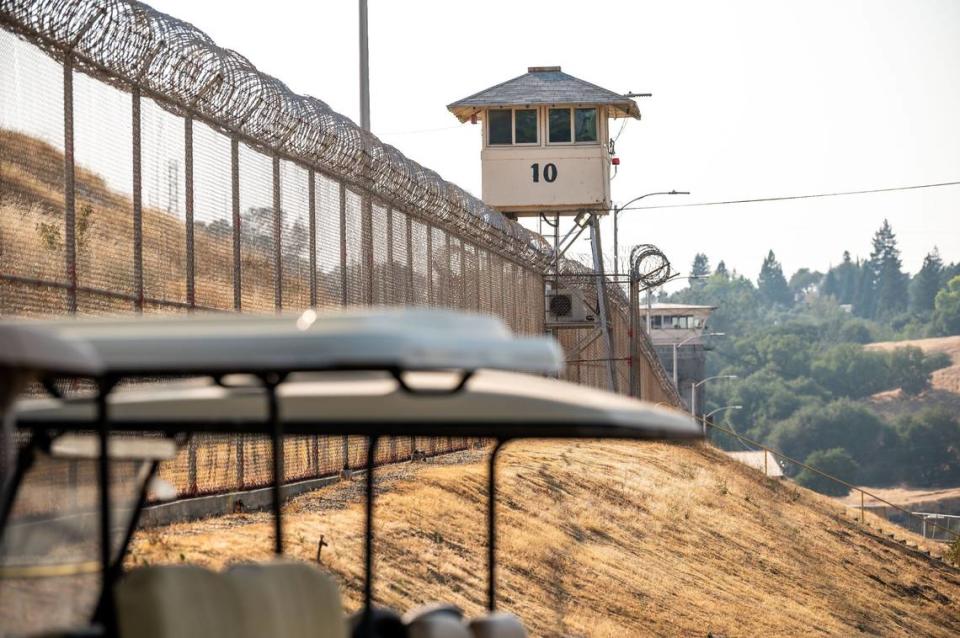California prisons say there is no solitary confinement. So why are inmates isolated for years?
The California Department of Corrections and Rehabilitation’s webpage on restricted housing includes this query: “Does CDCR have solitary confinement?”
The answer: “No.” With no further explanation.
Even as advocates say inmates can remain isolated for more than 21 hours per day for years, California prison officials insist that they do not use solitary confinement.
California prisons have long isolated inmates in separate housing units that significantly limit their contact with other people. Prisoners can live in these cells for years, and they frequently remain in cage-like settings even when they are allowed out for exercise, therapy or other programming.
Prisoners can be placed in solitary confinement for a variety of reasons, including disciplinary action, posing a threat to others and a need to be separated from other inmates for their own protection. There is no current limit on how long someone can remain in solitary confinement, and some inmates have stayed in isolation for decades.
CDCR recently released new regulations governing solitary confinement, which it now terms “restricted housing” and previously called “segregated confinement” or “secure housing.” But advocates say the agency still balks at defining a practice that needs wholesale reform.
“I think (CDCR) would like to continue to essentially operate in a world where there is no clear definition of solitary confinement or pretend that it doesn’t exist,” said Hamid Yazdan Panah, advocacy director for Immigrant Defense Advocates. “But it does exist. It’s the kind of situation that everyone knows what it is when they experience it.”

No definition of solitary confinement?
CDCR’s definition of restricted housing is vague. The agency’s webpage describes it as “various forms of confinement for individuals in CDCR custody.”
“CDCR offers a behavior-based housing model that focuses on providing the most programming opportunities for incarcerated people in the least restrictive setting, while still maintaining safety and security of institutions,” the agency continues.
CDCR spokeswoman Terri Hardy said the code that governs restricted housing does not contain a definition of solitary confinement. It is unclear how the agency distinguishes between the practices, other than using different phrases.
In response to questions about the agency’s rejection of the term “solitary confinement,” Hardy pointed to rules allowing isolated inmates non-contact visits, mail, phone calls and limited outside cell time. Some prisoners in this setting also get roommates.
However, most definitions of solitary confinement focus on how much time prisoners get outside their cells, as well as the amount of time they’re allowed to socialize with others.
The United Nations Standard Minimum Rules for the Treatment of Prisoners defines solitary confinement as “the confinement of prisoners for 22 hours or more a day without meaningful human contact.” Inmates who spend more than 15 days in isolation are in “prolonged solitary confinement,” which the rules consider torture.
Current CDCR rules give isolated inmates at least 10 hours of outside-cell time per week, meaning most remain in their cells for more than 20 hours per day.

A 2023 bill from Assemblyman Chris Holden, D-Pasadena — who has made repeated attempts to limit California’s use of solitary confinement — defines the practice as keeping inmates in their cells for more than 17 hours per day.
Assembly Bill 280 includes inmates housed with other people, as the criteria is based on “time spent in a cell and contact with persons other (than) custodial staff.”
Holden’s measure would limit solitary confinement in most cases to 15 consecutive days in prisons, jails and private and immigration detention facilities. It would ban the practice for inmates who are pregnant, 25 or younger, 60 or older or who have mental or physical disabilities.
AB 280 would also guarantee isolated inmates at least six hours per day of “daily out-of-cell congregate programming” and one hour of group recreation.
Panah said AB 280 is important because “there is no singular definition of solitary confinement in the state of California.” Holden’s bill would create a definition and a framework for the practice.
Gov. Gavin Newsom in 2022 vetoed a similar bill, although he called solitary confinement “ripe for reform” and directed CDCR to develop new regulations.
Those who oppose Holden’s bill say limiting solitary confinement would risk the safety of prison staff and other inmates, as the measure would make it significantly more challenging to separate those who threaten themselves or others.

Proposed Newsom reforms
Holden held AB 280 in the Assembly last month as a two-year bill, preferring to wait for the Newsom administration’s reforms.
But the assemblyman and advocates were disappointed when CDCR on Oct. 5 announced emergency changes that fell far short of the bill’s provisions.
The new rules would give inmates a minimum 20 hours of outside-cell time per week, would narrow the offenses that lead to solitary and would halve the amount of isolation time for those facing disciplinary measures.
The regulations would also allow inmates in solitary to earn credits that would cut down their isolation period and add some rehabilitative programming. They are set to take effect on Nov. 1.

